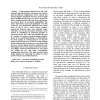Free Online Productivity Tools
i2Speak
i2Symbol
i2OCR
iTex2Img
iWeb2Print
iWeb2Shot
i2Type
iPdf2Split
iPdf2Merge
i2Bopomofo
i2Arabic
i2Style
i2Image
i2PDF
iLatex2Rtf
Sci2ools
ENGL
2007
2007
Computer Simulated Tests for Lever Controls with Circular Displays
— Using computer simulated tests, this study examined direction-of-motion stereotypes and response times for different configurations of lever controls and circular displays. Quantitative measures of the strength and reversibility of stereotypes were used to analyze the effects of pointer position, direction of turn instruction, and control plane on movement compatibility. The results showed that strong and significantly reversible stereotypes were obtained for horizontal and vertical levers, at the 12 and 9 o’clock pointer positions, respectively. Response times were generally longer when there were no clear movement stereotypes. In the analysis of contributions of component principles to overall stereotypes, the results were explained in terms of a number of common control operating principles. Based on the experimental findings, recommendations for check reading or resetting purposes are that the pointer should be placed at 12 and 9 o’clock positions for the horizontal and ver...
ENGL 2007 | Levers | Pointer Positions | Stereotypes |
Related Content
| Added | 13 Dec 2010 |
| Updated | 13 Dec 2010 |
| Type | Journal |
| Year | 2007 |
| Where | ENGL |
| Authors | W. H. Chan, Alan H. S. Chan |
Comments (0)

